A) $6
B) $9
C) $12
D) $15
F) B) and D)
Correct Answer

verified
Correct Answer
verified
Multiple Choice
For a monopoly, the socially efficient level of output occurs where
A) marginal revenue equals marginal cost.
B) average revenue equals marginal cost.
C) marginal revenue equals average total cost.
D) average revenue equals average total cost.
F) All of the above
Correct Answer

verified
Correct Answer
verified
Short Answer
Figure 15-1 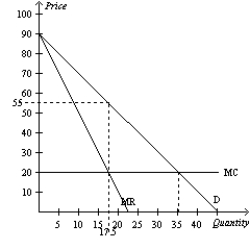 -Refer to Figure 15-1. If the monopolist uses perfect price discrimination, how much output does the firm produce?
-Refer to Figure 15-1. If the monopolist uses perfect price discrimination, how much output does the firm produce?
Correct Answer

verified
Correct Answer
verified
Short Answer
The fundamental cause of monopoly is
Correct Answer

verified
Correct Answer
verified
Multiple Choice
When a monopolist increases the amount of output that it produces and sells, average revenue
A) increases, and marginal revenue increases.
B) increases, and marginal revenue decreases.
C) decreases, and marginal revenue increases.
D) decreases, and marginal revenue decreases.
F) A) and C)
Correct Answer

verified
Correct Answer
verified
Multiple Choice
Since a monopolist faces a downward sloping demand curve,
A) the monopolist is able to sell all that it wants at whatever price the monopolist chooses.
B) it is necessary for the monopolist to lower the price to sell additional units of the good.
C) the monopolist sells only a fraction of the total sales of the good in the market.
D) the monopolist must always make an economic profit.
F) None of the above
Correct Answer

verified
Correct Answer
verified
Multiple Choice
Economists assume that monopolists behave as
A) cost minimizers.
B) profit maximizers.
C) price maximizers.
D) maximizers of social welfare.
F) B) and D)
Correct Answer

verified
Correct Answer
verified
Multiple Choice
Which of the following statements is correct?
A) The demand curve facing a competitive firm is horizontal, as is the demand curve facing a monopolist.
B) The demand curve facing a competitive firm is downward sloping, whereas the demand curve facing a monopolist is horizontal.
C) The demand curve facing a competitive firm is horizontal, whereas the demand curve facing a monopolist is downward sloping.
D) The demand curve facing a competitive firm is downward sloping, as is the demand curve facing a monopolist.
F) B) and C)
Correct Answer

verified
Correct Answer
verified
Multiple Choice
Figure 15-18 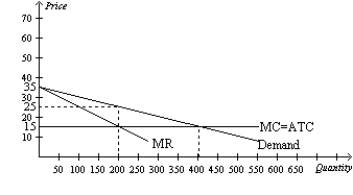 -Refer to Figure 15-18. If the monopoly firm perfectly price discriminates, then the deadweight loss amounts to
-Refer to Figure 15-18. If the monopoly firm perfectly price discriminates, then the deadweight loss amounts to
A) $0.
B) $1,000.
C) $2,000.
D) $4,000.
F) A) and C)
Correct Answer

verified
Correct Answer
verified
Multiple Choice
Which of the following is a characteristic of a natural monopoly?
A) Fixed costs are typically a small portion of total costs.
B) Average total cost declines over large regions of output.
C) The product sold is a natural resource such as diamonds or water.
D) All of the above are correct.
F) A) and C)
Correct Answer

verified
Correct Answer
verified
Multiple Choice
Price discrimination
A) forces monopolies to charge a lower price as a result of government regulation.
B) is an attempt by a monopoly to prevent some customers from purchasing its product by charging a high price.
C) is an attempt by a monopoly to increases its profit by selling the same good to different customers at different prices.
D) increases the consumer surplus associated with a monopolistic market.
F) A) and B)
Correct Answer

verified
Correct Answer
verified
Multiple Choice
Table 15-4
A monopolist faces the following demand curve: 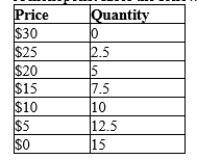 -Refer to Table 15-4. If the monopolist produces 10 units, what is its average revenue?
-Refer to Table 15-4. If the monopolist produces 10 units, what is its average revenue?
A) $100
B) $15
C) $10
D) $1
F) C) and D)
Correct Answer

verified
Correct Answer
verified
Multiple Choice
Table 15-19
A monopolist faces the following demand curve: 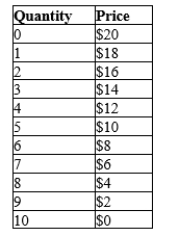 -Refer to Table 15-19. If a monopolist faces a constant marginal cost of $5, how much output should the firm produce in order to equate marginal revenue with marginal cost?
-Refer to Table 15-19. If a monopolist faces a constant marginal cost of $5, how much output should the firm produce in order to equate marginal revenue with marginal cost?
A) 3 units
B) 4 units
C) 5 units
D) 6 units
F) B) and D)
Correct Answer

verified
Correct Answer
verified
Multiple Choice
If a monopolist sells 100 units at $8 per unit and realizes an average total cost of $6 per unit, what is the monopolist's profit?
A) $200
B) $400
C) $600
D) $800
F) All of the above
Correct Answer

verified
Correct Answer
verified
True/False
A monopolist does not have a supply curve because the firm's decision about how much to supply is impossible to separate from the demand curve it faces.
B) False
Correct Answer

verified
Correct Answer
verified
Multiple Choice
Table 15-13
The following table gives information on the price, quantity, and total cost of production for a monopolist. 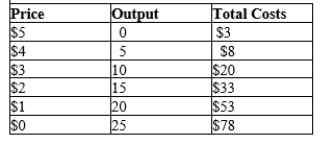 -Refer to Table 15-13. How much profit will the firm earn at the profit-maximizing price?
-Refer to Table 15-13. How much profit will the firm earn at the profit-maximizing price?
A) $9
B) $12
C) $15
D) $18
F) A) and C)
Correct Answer

verified
Correct Answer
verified
Multiple Choice
Table 15-19
A monopolist faces the following demand curve:  -Refer to Table 15-19. If a monopolist faces a constant marginal cost of $3, how much output should the firm produce?
-Refer to Table 15-19. If a monopolist faces a constant marginal cost of $3, how much output should the firm produce?
A) 3 units
B) 4 units
C) 5 units
D) 6 units
F) A) and D)
Correct Answer

verified
Correct Answer
verified
Multiple Choice
Which of the following is an example of price discrimination?
A) Nabisco provides cents-off coupons for its products.
B) Amtrak offers a lower price for weekend travel compared to weekday rates on the same routes.
C) Hotel rates for AAA members are lower than for nonmembers.
D) All of the above are correct.
F) B) and C)
Correct Answer

verified
Correct Answer
verified
Multiple Choice
Scenario 15-6 The concert promoters of a heavy-metal band, WeR2Loud, know that there are two types of concert-goers: die-hard fans and casual fans. For a particular WeR2Loud concert, there are 1,000 die-hard fans who will pay $150 for a ticket and 500 casual fans who will pay $50 for a ticket. There are 1,500 seats available at the concert venue. Suppose the cost of putting on the concert is $50,000, which includes the cost of the band, lighting, security, etc. -Refer to Scenario 15-6. How much additional profit can the concert promoters earn by charging each customer their willingness to pay relative to charging a flat price of $50 per ticket?
A) $25,000
B) $50,000
C) $75,000
D) $100,000
F) A) and C)
Correct Answer

verified
Correct Answer
verified
Multiple Choice
Scenario 15-2 Consider a local, privately-owned electrical cooperative named Poweshiek Power Company (PPCo) . PPCo has just completed a clean-coal-burning electrical power plant in Iowa. Currently, PPCo can meet the electricity needs of all residents in the county. In fact, its capacity far exceeds the needs of the county. After just a few years of operation, the shareholders of PPCo experienced incredibly high rates of return on their investment due to the profitability of the corporation. -Refer to Scenario 15-2. Which of the following statements is most likely to be true? (i) New entrants to the market know they will have a smaller market share than PPCo currently has. (ii) PPCo is a natural monopoly. (iii) PPCo would experience higher profits if it were government-run.
A) (i) and (ii) only
B) (ii) and (iii) only
C) (i) and (iii) only
D) (i) , (ii) , and (iii)
F) A) and D)
Correct Answer

verified
Correct Answer
verified
Showing 621 - 640 of 662
Related Exams